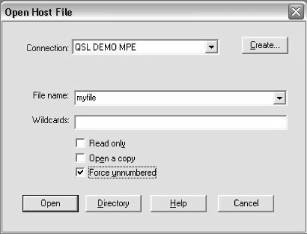 |
 |
|
|
|

January 2004
Get the most out of your Robelle Tools
Handling Qedit Line Numbers
By
François Desrochers
Qedit
is able to handle numbered as well as unnumbered files. Qedit
determines the type of file it’s dealing with by looking at
specific portions of each line based on the Language of the file.
Qedit can handle up to 99,999,999 lines in regular numbered files and
999,999 lines in Cobol source files. The maximum is attained if the
smallest increment allowed (0.001) is used and all possible line
number values are present (there are no “holes” in the
sequence). In other words, you will be able to add new lines by
changing the increment or using unassigned line numbers. Qedit is
able to adjust the increment and renumber parts of the file as
needed.
When it comes to line numbers, Qedit goes by the following rules. If this is a COBOL source file, Qedit expects the line numbers in the first 6 columns of each line. For some other files, it expects line numbers in the last 8 columns of each line. Furthermore, the first 5 lines of the file must contain valid numbers (all numeric digits) and be in ascending order. If one of these requirements is not met, Qedit reports a line number error and does one of 2 things:
• Assumes the file is unnumbered, assigns its own line numbers and handles line number columns as part of the data.
•
Assumes there is a problem in the line numbering scheme and assigns
line numbers starting from the last valid number.
A
number of factors influence which option is used.
False Alarm
There
are cases where Qedit thinks the file is numbered when, in fact, the
columns contain actual numeric data. If you need to edit such files
but keep getting error messages and are not able to see the numeric
data, simply use the Unnumbered option on the Text command. In this
case, the data is used as line number which makes for an unusual list
of values. On a side note, MPE’s Print command also looks for
line numbers in the last eight columns. If the output doesn’t
look right, you should use the Nonum option to see if this might be
the problem. This is one of the most common questions we get on
Suprtool when people try to check the results of an extract task.
abc
12345678
def 23456789
ghj 34567890
:qedit
/t myfile
12345.678 abc
23456.789 def
34567.89 ghj
/t myfile,unn
/l all
1 abc
12345678
2 def
23456789
3 ghj
34567890
/e
:print myfile
abc
def
ghj
:print myfile;nonum
abc 12345678
def 23456789
ghj 34567890
Invalid
Line Numbers
In the case of invalid line numbers or out-of-sequence line numbers, Qedit displays an error message and tries to recover from the error. Let’s say you have the following Cobol file on HP-UX:
000110*VERSION
“Version Robelle 1.1 2003”
000130
IDENTIFICATION DIVISION.
002222
PROGRAM-ID. POPRINT.
000150
ENVIRONMENT DIVISION.
000160
CONFIGURATION SECTION.
000170
SOURCE-COMPUTER. HP3000.
000180
OBJECT-COMPUTER. UNIX.
000280
INPUT-OUTPUT SECTION.
Keep in mind that COBOL line numbers have three decimal places so the first line is 0.11, not 110. It’s also worth noting that the default increment is 0.1. A simple Text will get you the following error:
qux/t
cobnonum.pco
‘Language’ is now COBX
Error: line
number out of sequence (000150) –
renumbering
the rest. 9050 lines in file
qux/listj [
0.11
*VERSION “Version ECOMETRYRev532:1”
0.13
IDENTIFICATION DIVISION.
2.222
PROGRAM-ID. POPRINT.
2.322
ENVIRONMENT DIVISION.
2.422
CONFIGURATION SECTION.
2.522
SOURCE-COMPUTER. HP3000.
2.622
OBJECT-COMPUTER. UNIX.
Notice the original line 0.15 ENVIRONMENT DIVISION. is now 2.322 (last valid line number 2.222 incremented by 0.1). In this case, line 2.222 is likely incorrect and should be fixed. Aside from the new numbers, the file is intact and Qedit has been able to text it all in.
Important: The line number on the out-of-sequence error message has been added in version 5.4.11. Earlier versions do not provide the information making it hard to find which line needs to be fixed.
Running Out of
Line Numbers
Now let’s
say the invalid line number above (2.222) is 999.992 instead. Qedit
tries to renumber the remaining lines from that value with an
increment of 0.1.
qux/t cobnonum.pco
‘Language’ is now COBX
Error: line
number out of sequence
(000150) -
renumbering the rest
Error: Too High
23 lines in file
qux/l all
0.11
*VERSION “Version ECOMETRYRev532:1”
0.13
IDENTIFICATION DIVISION.
997.992
PROGRAM-ID. POPRINT.
998.092
ENVIRONMENT DIVISION.
998.192
CONFIGURATION SECTION.
998.292
SOURCE-COMPUTER. HP3000.
998.392
OBJECT-COMPUTER. UNIX.
998.492
INPUT-OUTPUT SECTION.
....
Qedit
will run out of line numbers very quickly causing the Error: Too High
message. This error is a lot more serious than a simple renumbering.
When this error occurs, Qedit stops reading the file. That’s why
it shows 23 lines in the file instead of the expected 9,050 above.
It’s very important not to keep the file.
How To Fix Line Number Problems
If there
really is a problem, here’s how you go about fixing the line
numbers. If Qedit does not run out of line numbers, Text the file in
and use the Renum command.
There
are a few options when Qedit runs out of line numbers. You can force
Qedit to use a specific increment by specifying the Setincr option on
the Text command. For example, the following commands forces Qedit to
use a .01 increment instead of the default.
/Set Incr .01
/T myfile,setincr
If
that does not work, you have to see the numbers. In order to do this,
use the Unnumbered option on the Text command. Line numbers now
appear as data. Find the invalid line number displayed in the error
message (if any). If there are just a few lines to fix, enter valid
numbers where needed. If there’s a large number of lines to fix,
it may be easier to remove them all with a Change command and
re-enter a valid sequence in the first 10 lines or so. Keep the file
and Text it back in.
Qedit for
Windows
If you get a
line number problem in Qedit for Windows older than 5.4.10, you will
not get any error. In versions 5.4.10 or later, you will get the
message shown in Figure 1.
 |
Qedit for Windows
does not have equivalents for the Set Incr and Renum commands and
Setincr option. There is, however, an equivalent for the Unnumbered
option. Just enable the Force Unnumbered option as shown in Figure 2
on the Open Host File or Directory dialog boxes.
 |
If you do not
have host-based Qedit but have the Qedit for Windows server, you
should open the file with Force Unnumbered enabled and fix the line
numbers.
Where Do
Invalid Numbers Come From?
Based on our
experience, invalid line numbers come from editing files using tools
that are not “line number”-aware. Although this could
happen on MPE, it’s most often seen on HP-UX. This could be as
simple as adding lines using I/O redirection (“>” or
“>>”) on MPE or HP-UX commands. It could also be done
by more complex software such as version control packages. Often
times, the offending lines have been imported from foreign systems.
Once the root cause has been identified, it is important to document
it properly and maybe set internal standards to prevent it in the
future.
Copyright The 3000 NewsWire. All rights reserved.